Designing a Kitchen Island Can Seem Complex
But with the right advice, it becomes a lot more straightforward
Whether you're updating your existing kitchen or starting from scratch, the island often becomes the heartbeat of the room. In this guide, we give you useful tips on kitchen island design.
From picking the right size and shape to finding the best materials and colours, we guide you through the process. We emphasise not only on visual appeal, but also on functionality, suiting to your cooking needs and living style.
Let's get started on making a kitchen island that doesn't only look good, but also works for you.
Key Considerations in Kitchen Island Planning
Designing the ideal kitchen island necessitates a well-thought-out approach. There are several key elements to take into account to make sure your island doesn't just carry aesthetic appeal, but also integrates smoothly into your kitchen structure and serves your practical requirements.
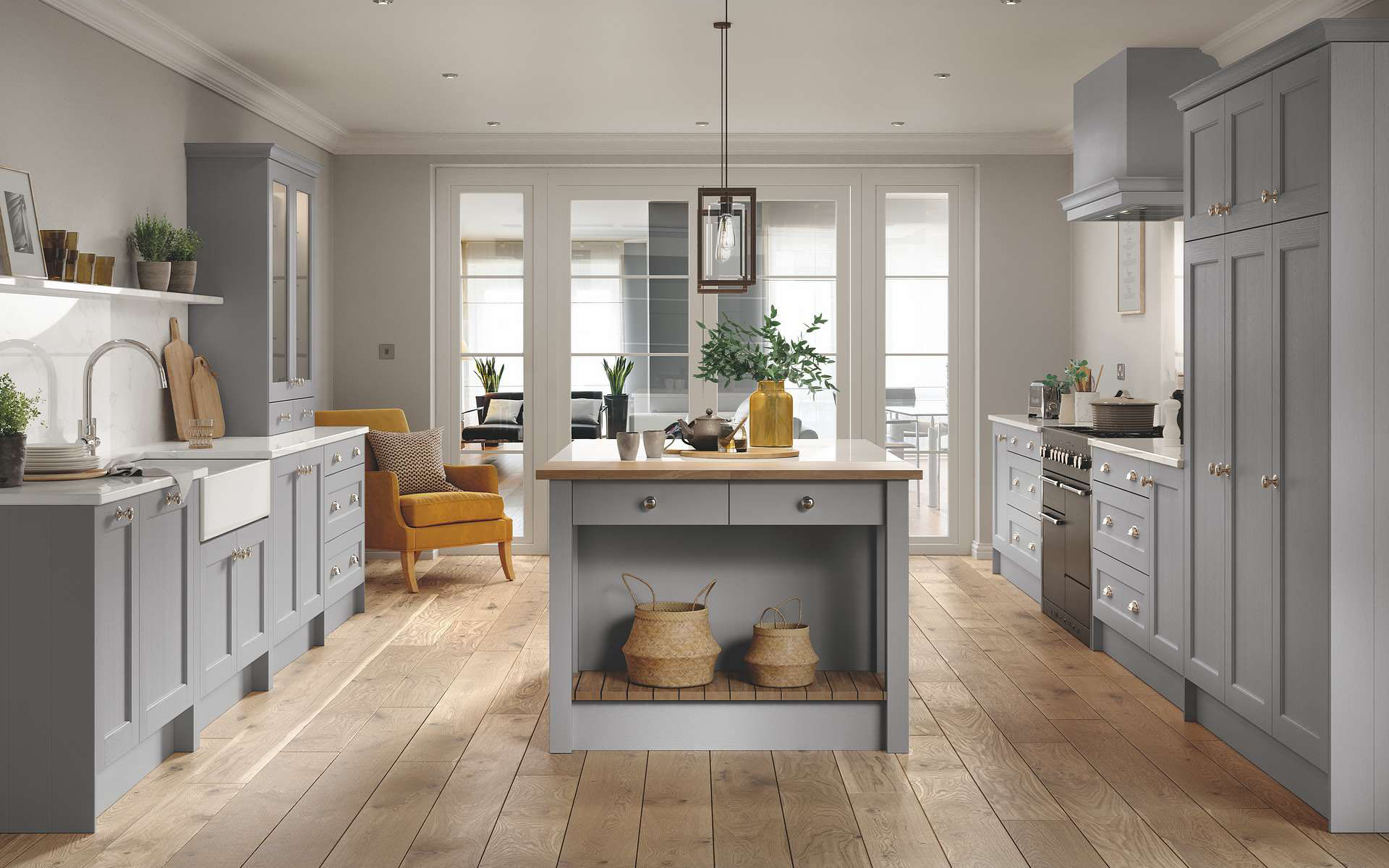
In this segment, we will look into numerous underlying factors that are crucial in the preparatory phase of your kitchen island layout design.
Assessing Size and Proportion
Your kitchen island should seamlessly blend into the proportion of your overall kitchen.
Strive for an island design that offers a generous working area as well as storage capacity, while maintaining a minimum clearance of 90 - 100 cm or 36 - 40 inches or more all around so as to facilitate smooth mobility and accessibility.
If you're contemplating island ideas for kitchen spaces that are smaller, a slender island that won't dominate the surrounding space may be the best option.
Ensuring Sufficient Space Around the Island
It's absolutely essential to maintain a minimum clearance around your kitchen island to ensure a practical kitchen layout.
However, anything larger than 150 - 180 cm or 60 - 71 inches can make the island seem detached from the kitchen design and exacerbate the risks associated with walking across open walkways while handling hot pans, amongst other things.
This space contributes to seamless movement and easy accessibility to kitchen appliances and cupboards. If your kitchen flows into dining or living spaces, you must make necessary adjustments to this space accordingly.
Deciding Between Fitted and Freestanding Islands
Installing a built-in island into your kitchen design gifts you with the advantage of streamlined aesthetics besides maximising both storage and workspace, ideal for large or busy kitchens.
On the flip side, freestanding islands offer the boon of flexibility, making them a top choice for smaller kitchens or multipurpose rooms.
Their power lies in their capacity to modify the layout when required and infuse an exclusive, diverse vibe into your kitchen.
Given the dynamics of implementing an island into your kitchen design, the pros and cons of each are:
Pros of Built-in Kitchen Islands
- Versatile Storage: They provide ample storage space for a variety of kitchen appliances and utensils, thus organising your kitchen.
- Added Workspace: A built-in kitchen island creates an extra workspace for cooking prep or dining.
- Streamlined Aesthetics: These islands enhance the streamlined look of your kitchen, adding to its sophistication.
- Enhanced Functionality: A kitchen island can serve multiple purposes, from food preparation to a cosy breakfast bar in your kitchen.
Cons of Built-in Kitchen Islands
- Limit Space: In smaller kitchens, a built-in island may take up too much room, making the area feel cramped.
- Cost: Depending on the design and materials, built-in kitchen islands can be costly.
- Permanent Construction: Being built-in, it might be harder to change the kitchen layout in future, as it will be a permanent part of the space.
Pros of Freestanding Kitchen Islands
- Flexible: These can be moved or removed depending on your requirements, offering a dynamic kitchen design experience.
- Cost-effective: Comparatively less expensive as they do not require custom designs or materials.
- Versatile: Freestanding islands come in a variety of designs and sizes, allowing you to find one that perfectly suits your kitchen.
Cons of Freestanding Kitchen Islands
- Less Storage: Often, freestanding islands provide lesser storage capacity compared to their built-in counterparts.
- Stability: These may not be as stable as built-in islands, and could move while you are using them.
Using Shapes for Visual Interest
The shape of your island can transform your kitchen's aesthetic and functionality. Rectangular islands fit well in most traditional and modern kitchens, providing ample workspace.
Curved or L-shaped islands can soften the kitchen's look and are great for enhancing social interaction.
Custom shapes like T-shaped or oval islands can become a statement piece and work well in large, open-plan kitchens.
Aesthetic Choices for Your Kitchen Island
Your kitchen island's aesthetics are crucial as they largely dictate your kitchen's overall atmosphere. By wisely choosing the colour, the worktop material, and the lighting, you can not only boost your island's look but also its usefulness.
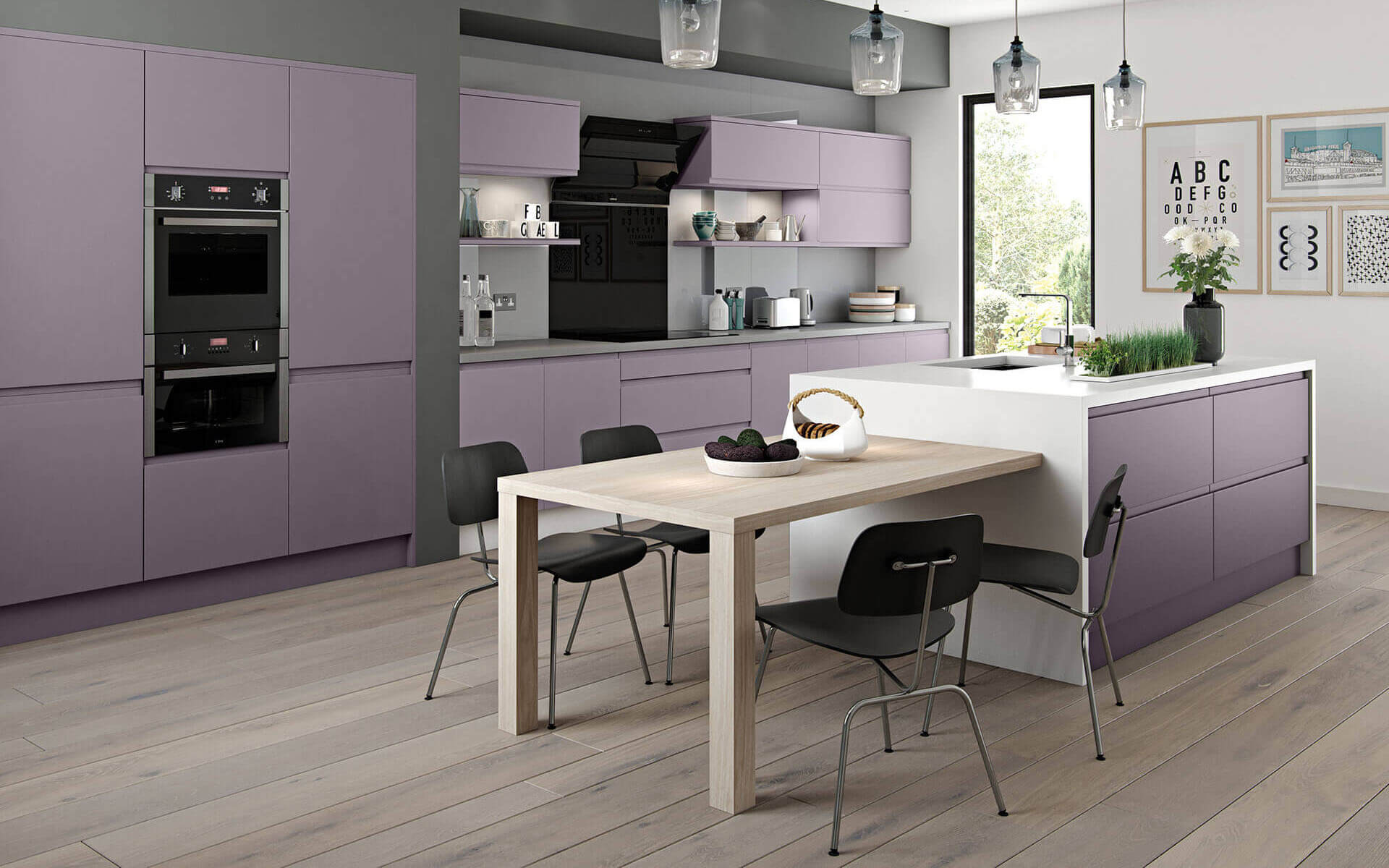
Velluto Lavender Handleless Kitchen with Waterfall Worktop Island Feature with Built-In Table from Better Kitchens
Experimenting with Colour
The choice of colour can have a transformative effect on your kitchen island's aesthetic. Opting for bright, rich colours can provide a striking contrast with the overall kitchen décor, making a bold visual statement.
Alternatively, understated, neutral tones can endow your kitchen island with a subtle and sophisticated charm. If you're unsure about a permanent colour choice, consider using versatile accessories like bar stools or ornaments in your preferred colour scheme.
| Colour | Description | Suggested Accessories |
|---|---|---|
| Bright Red | Bold and dynamic, but needs to be balanced with neutral tones in the kitchen. | Silver or chrome bar stools, white decorative items. |
| Amber Yellow | Warm and inviting, perfect for open-plan kitchens. | Wooden bar stools, terracotta ornaments. |
| Cobalt Blue | Makes a strong visual impact, contrasts well with wood and beige tones. | Brass or gold bar stools, cream decorations. |
| Moss Green | Pairs well with white and wood, giving a calming and harmonious vibe. | White bar stools, botanical décor items. |
| Neutral Grey | Subtle and sophisticated, works well with nearly any colour scheme. | Leather bar stools, metal or glass ornaments. |
Selecting the Ideal Worktop
Your kitchen worktop island isn't merely a utilitarian zone but a substantial component of the overall island design. Opt for granite or quartz if you'd like to add a touch of luxury and longevity to your kitchen.
Solid wood, on the other hand, imparts a welcoming and organic feel. If you're leaning towards a more modern ambiance, materials such as stainless steel or concrete might be a suitable choice.
Always keep in mind the need for maintenance, durability, and how well the worktop material aligns with other aspects of your kitchen.
Incorporating Lighting Design
Your kitchen island's lighting ought to strike a balance between functionality and visual appeal. Opting for pendant lights can deliver a chic impression while effectively covering the workspace with light.
If you prefer a more stripped-back aesthetic, consider built-in lights or a series of compact spotlights to ensure you have sufficient light without overwhelming the space.
Adjustable lighting is another prudent option, allowing you to easily switch from bright task-focused lighting to a more subdued ambience as required.
Your kitchen island is not only a functional component but also a central aesthetic element that has the potential to transform the overall ambiance of your kitchen. To that end, incorporating appropriate lighting solutions can amplify the beauty of your island while also simplifying work processes.
Here are some noteworthy and unique kitchen island ideas related to lighting:
- Pendant Lights: Ideal for kitchen islands small kitchens, hanging pendant lights create a warm and inviting atmosphere while offering necessary task lighting for food preparation.
- Recessed Lighting: A practical kitchen island idea for small kitchens, recessed lighting offers bright illumination without using up any surface or hanging space.
- Track Lighting: An excellent modern kitchen island idea is to employ track lighting. With multiple light heads, these fixtures are versatile and perfect for directing light exactly where it's needed. They're a great option for L shaped kitchen and island layouts as well.
- Under-cabinet Lights: Especially useful for kitchen islands with seating, under-cabinet lights gently illuminate the worktop island, creating a cosy and intimate ambiance.
- LED Strip Lights: These lights are flexible and can be adapted to illuminate any shape or size of kitchen island. It's an exciting island design in kitchen concept, particularly for contemporary kitchen islands.
Considering your kitchen layout, be it L shaped kitchens with an island or designs without one, choosing the right lighting concept for your kitchen island can significantly enhance the kitchen's functionality and aesthetic appeal.
Enhancing Functionality and Usability
Although visual appeal matters, it's the practicality and effectiveness of your kitchen island that truly defines its daily usefulness.
Emphasising on indispensable facets such as cooking space, seating configurations, and comprehensive functionality guarantees that your island isn't merely a decorative piece, but an integral element contributing to the efficiency of your kitchen.
Creating Adequate Space for Food Preparation
When designing your kitchen island, the emphasis should primarily be on functionality, particularly related to food preparation.
To achieve this, ensure there is ample surface area for effortless chopping, mixing and assembling dishes – this is paramount.
Utilising materials like durable hardwood or granite for the work surface area not only provides longevity but also facilitates cleaning.
Adding nuanced features such as integrated chopping boards or hideaway bins can maximise the efficiency of the prep area. Equally important is to include under-counter storage for convenient accessibility to cookware and utensils.
| Work Surface Material | Benefits |
|---|---|
| Hardwood | Hardwood brings warmth and a natural aesthetic to your kitchen. It is also highly durable and can withstand the rigours of kitchen work. A well-maintained hardwood work surface can last for several years, making it a cost-effective choice. |
| Granite | Granite is known for its toughness and resistance to scratches and burns. It handles the heat of hot pots and pans better than most materials. Its variety of patterns and colours can provide a luxurious finish to your kitchen island. |
| Stainless Steel | Stainless steel gives a sleek, modern look to your kitchen island. It is exceptionally durable, resistant to water damage, and easy to clean. This material is perfect for a contemporary kitchen island design. |
| Quartz | Quartz is a non-porous material, making it resistant to stains and bacteria. It is also incredibly durable and requires little maintenance. The wide range of colours and patterns available make quartz a versatile choice for any kitchen design. |
Designing an Effective Seating Plan
The heart of your kitchen could well be the island, with seating transforming it into a social anchor. Contemplating ideas for kitchen island seating requires due attention to legroom - around 30 cm beneath the counter is typically sufficient.
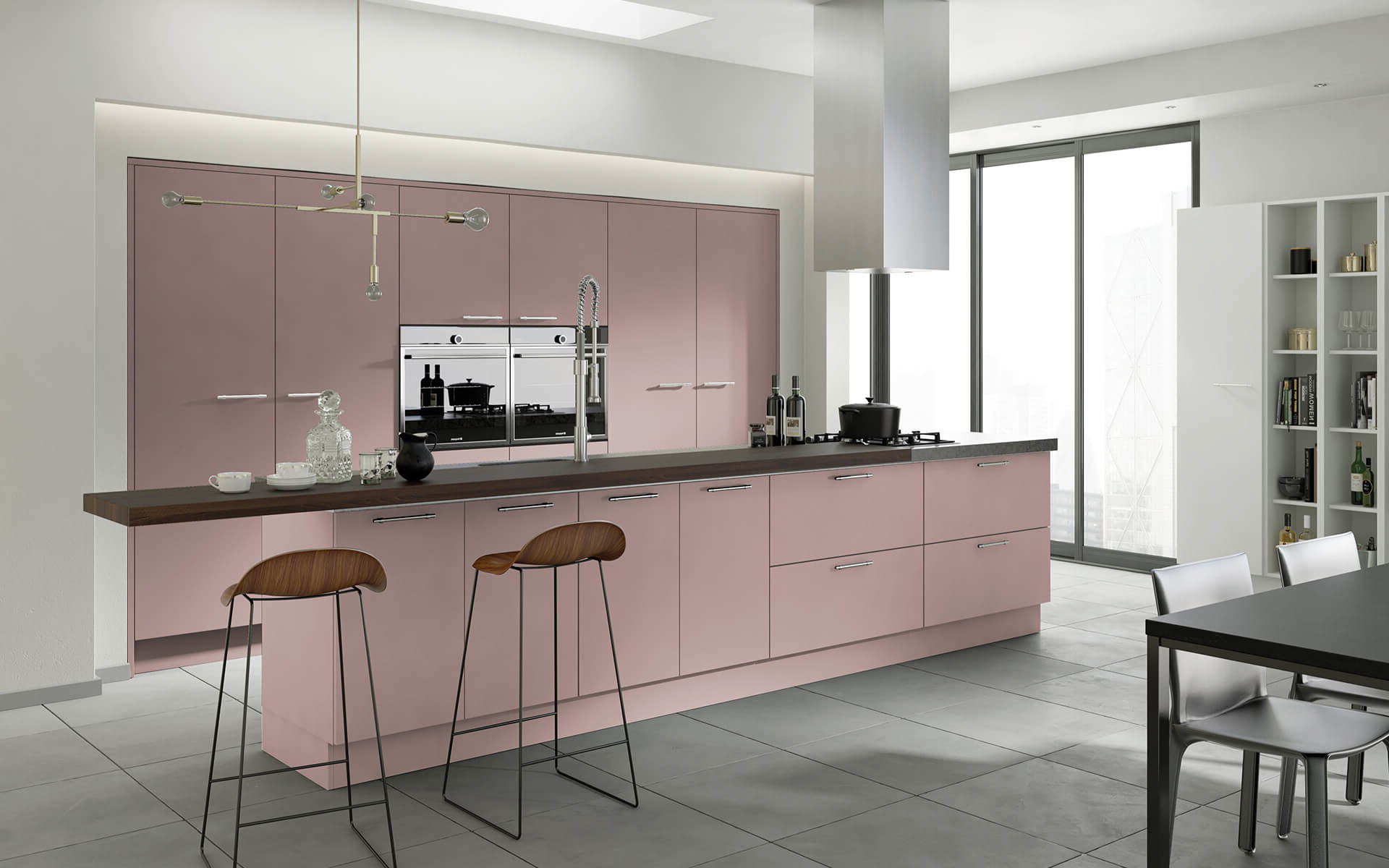
Breakfast Bar Overhang on Kitchen Island from Better Kitchens
Select seating that marries well with your island's height, and won't impede movement when not employed. A kitchen island idea small kitchens can adopt is an overhanging countertop or a slightly dropped section that offers enhanced comfort during meals.
Be mindful to balance the seating capacity with the need to maintain a functional workspace and convenient kitchen flow.
Ideal Island size width per person
Considering space and functionality, the ideal kitchen island size width per person should generally range between 60 to 80cm or 24 to 32 inches.
This allows comfortable movement, meal preparation, and social interaction while respecting the proportions of the kitchen's overall layout, particularly in small kitchens where efficiency is key.
| Number of Persons | Required Width (cm) | Required Width (Inch) |
|---|---|---|
| 2 | 120 - 160cm | 48 - 63" |
| 3 | 180 - 240cm | 70 - 94" |
| 4 | 240 - 320cm | 94 - 126" |
| 5 | 300 - 400cm | 118 - 157" |
Maximising Island Functionality
In order to maximise the functionality of your kitchen island, it should be customised to suit your personal requirements. Consider the addition of various appliances including a sink, dishwasher or a hob.
This approach can morph your island into a resourceful working area.
Ensure you incorporate sufficient power outlets for your smaller appliances, consider intelligent storage options like drawers and cupboards, and you may even want to consider specific features such as wine racks or bookshelves to fully capitalise on your kitchen island.
Don't forget to utilise vertical space – installing shelves above your island can provide both practical additional storage and create a visually pleasing display area.
Design and Style Considerations for Kitchen Islands
Your kitchen island's design and style are key elements in establishing your kitchen's overall aesthetic. Whether it's matching with your current cabinets, choosing the right materials, or incorporating striking designs, these factors are crucial in creating a harmonious and fashionable kitchen.
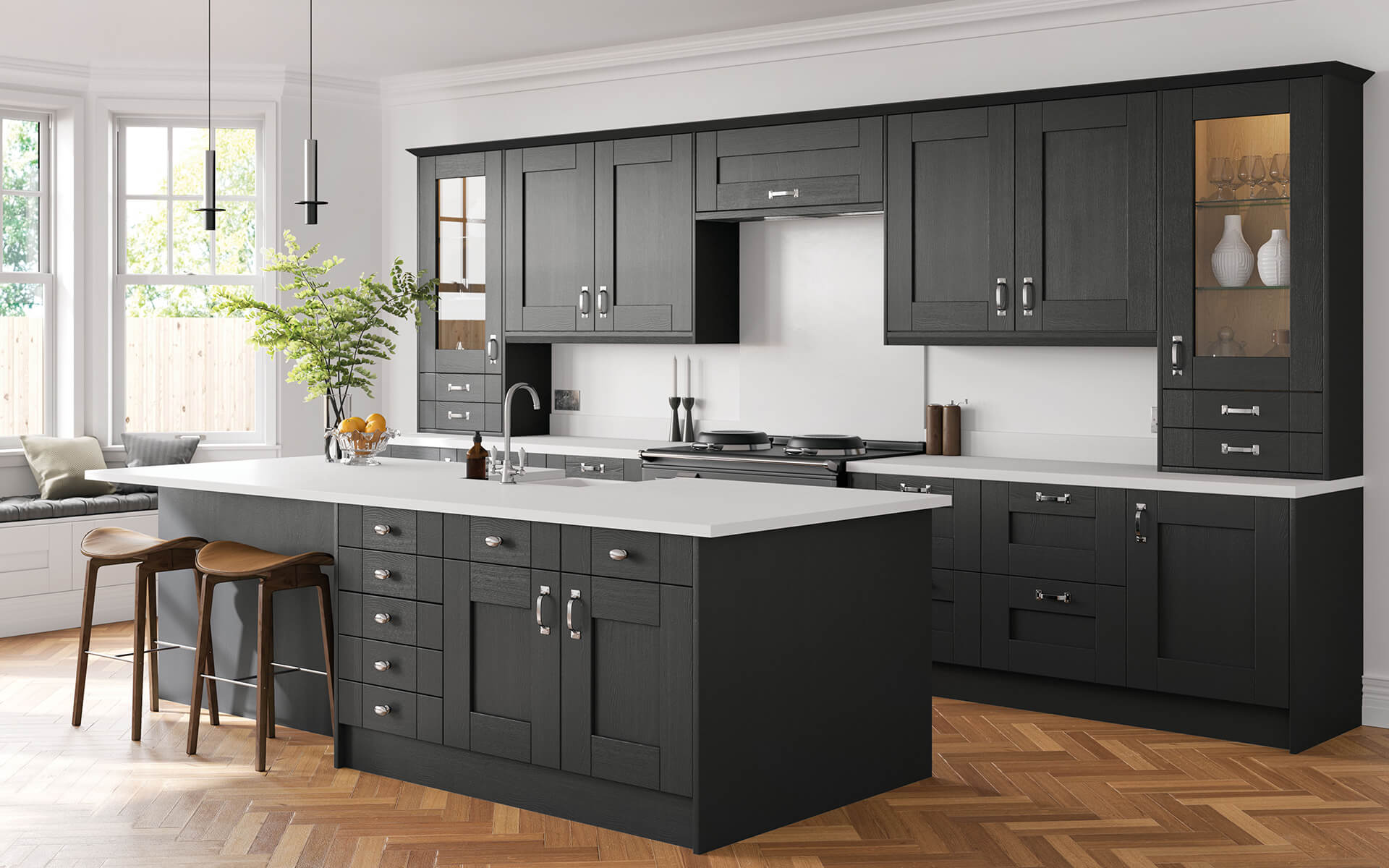
Lynton Graphite Shaker Kitchen with Corner Seating Area on Island from Better Kitchens
Coordinating with Cabinets
Fashioning a harmonious aesthetic in your kitchen frequently implies integrating your island design with your kitchen cabinetry. This doesn't inevitably mean perfectly matching colours and materials; instead, it's about finding a balanced harmony.
To present a unified appearance, your island can echo your cabinetry's style and shade. Conversely, if you're angling for a more vibrant design, consider accentuating your island against your cabinetry - imagine a striking island hue set against understated cabinets, or vice versa.
The essence is to sustain a consistent thread, be it through material, colour scheme, or finish.
Integrating Stools and Seating Solutions
When you're designing a kitchen island, it's important to remember that seating isn't just a practical consideration. It has the power to significantly influence the style of your island.
Choose chairs or stools that accentuate the island's appearance, thinking about their form, materials, and colour palette.
If your taste leans towards the contemporary, simple, modern stools in materials such as metal or acrylic might be your best bet.
Conversely, if you favour more traditional kitchen designs, consider using classically styled wooden stools or cushioned chairs to foster a cosy ambiance.
Just don't forget to check that the height of the seating you choose works well with the height of the island, guaranteeing enough room for leg space.
Material Choices: Marble, Metal, and Wood
Selecting the correct materials for your kitchen island can greatly influence both its functionality and aesthetic appeal. Marble, a classic material, elevates any space with its luxurious and sophisticated presence,
However, be prepared for its upkeep to make it stay pristine. For modern kitchen islands, stainless steel is an attractive, durable and easily maintained option, suitable for high-traffic kitchens.
On the other hand, wood effortlessly creates character and warmth in the room and its style versatility can range from traditional to rustic depending on the selected finish.
Balancing practical values such as durability and ease of upkeep with their visual impact can guide you toward the best choice for your specific usage requirements and overall kitchen design.
Impactful Designs: Mirrored Surfaces and Bold Colours
If you're setting your sights on designing a standout kitchen island, incorporating glossy or mirrored surfaces or embracing bold colours can add a touch of elegance and personality.
Mirrored or gloss-finished islands not only reflect light beautifully, they also help to create a feeling of spaciousness and opulence in the room. Bold colours, on the contrary, can infuse life and character into your kitchen.
It could be a dynamic hue of blue, a lush green, or even a bold red; a brightly hued island can instantly become the heart of your kitchen.
Remember, when choosing bold colours, it's key to ensure they blend well with your overall kitchen colour scheme to maintain harmony.
Thematic Styling for Kitchen Islands
Your kitchen island's design can greatly affect the mood and style of your kitchen.
Whether your preference leans towards a quaint countryside feel, a smooth modern appeal, or somewhere in the middle, a thematic approach to design forms an integral part of forming an attractive and united space.
From Country Charm to Contemporary Elegance
Designing a kitchen island requires careful consideration of your overall theme. If you're leaning towards a rustic ambiance, make use of organic elements like timber and stone, and embrace a rich, welcoming palette of colours.
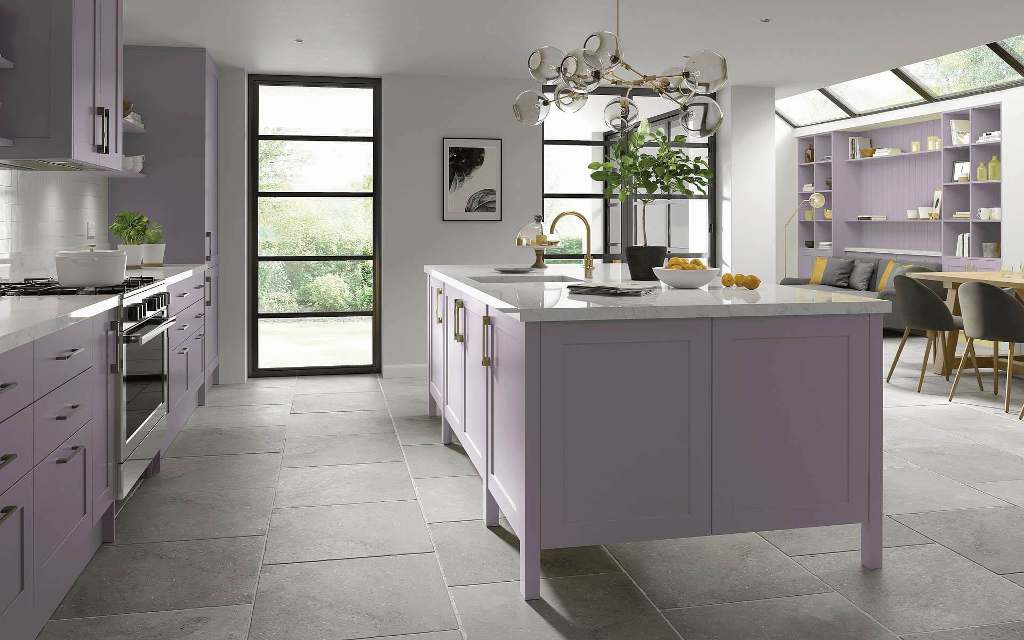
Millwood Shaker Kitchen With Large Feature Island from Better Kitchens
Adding intricate details such as antiquated knobs or a farmhouse-style basin can amplify this effect. On the other hand, a contemporary kitchen island embodies simplicity and sophistication.
Achieve this with uncluttered lines, a minimalist aesthetics, and a colour scheme restricted to monochromatic or neutral shades. Opt for surfaces like polished granite or stainless steel to convey a modern appeal.
Don't overlook the role lighting can play; from hanging pendant fixtures for a rustic space to trim LED strips for a modern setting.
Playing with Colours and Themes
Colour serves as a significant element in theme-based styling. You can breathe life into your kitchen by integrating vibrant hues either on the island or via seating and accessories.
On the other hand, if you're inclined towards a refined look, consider lighter pastels or the timeless greys and whites for a serene and elegant feel.
The theme could also take its cue from different cultural motifs or time periods – a Mediterranean azure or a sleek Scandinavian minimalist design, for instance.
The crux is to maintain consistency and equilibrium – your chosen colours should enhance and not clash with the overall décor of your kitchen.
| Theme | Recommended Colour | Suggested Application |
|---|---|---|
| Mediterranean | Shades of Azure or Blue | Kitchen Island or Accessories |
| Scandinavian Minimalist | Monochromatic Whites or Greys | Kitchen Island |
| Rustic Country | Earthy Tones | Kitchen Island or Seating |
| Modern Contemporary | Bright, Vibrant Colours | Accent Pieces |
| Classic Elegance | Light Pastels | Whole Kitchen, including Island |
Rustic, Coastal, and Chic Styling Choices
Stay true to rustic charm by procuring natural, untreated elements. Visualise worn wood, weathered finishes, and a deep, earthy colour scheme to lend a snug and inviting ambiance to your kitchen.
If a seaside-inspired theme is on your mind, think soft whites and light blues, and raw materials such as reflective glass or light-toned timber. Complement this island design in the kitchen with naval-themed accents to captivate this look.
For a refined touch, consider a sleek, polished aesthetic by employing elegant colours such as dark green, navy, or black, amplified by opulent trappings like brass hardware or marble worktops.
This chic style embodies a sense of tasteful sophistication and subtle grandeur.
Functional Features of Kitchen Islands
A kitchen island is more than a mere visual attraction, it's reliability and usability matter as well.
By diligently setting up appliances, optimising storage, integrating creative lighting and shelves, and meticulously thinking about the relative size and format, your kitchen island can morph into a fashionable, high-functioning workspace.
Incorporating Appliances and Storage
Optimising your kitchen island features is a viable strategy to enhance both functional and aesthetic elements in your kitchen.
You can incorporate built-in appliances such as dishwashers, wine coolers, or even compact ovens, thereby boosting practicality.
Aside from appliances, attention must also be given to storage options. Deep drawers designed for pots and pans, designated pull-out bins for general waste and recyclable items, along with bespoke compartments for kitchen utensils, can help maintain a tidy and well-arranged kitchen atmosphere.
The approach should be to achieve a harmonious marriage of style and practicality in your kitchen island design, ensuring the integrated appliances complement the overall aesthetic.
| Integrated Appliance | Functional Benefits | Aesthetic Considerations |
|---|---|---|
| Dishwasher | Conveniently close to dining and cooking areas. Saves walking distance when loading and unloading. | Can be hidden within cabinetry to avoid disrupting overall kitchen aesthetic. However, select a model with exterior harmonious to the kitchen theme. |
| Wine Cooler | Temperature-controlled storage for wines. Convenient access when serving guests on the island. | Usually glass-fronted, providing a sophisticated appearance and showcasing wine collection. Ensure it complements the kitchen style. |
| Compact Oven | Useful for heavy-cooking households. Saves space in main cooking area. | Can provide a sleek, modern look, but ensure the finish matches other kitchen appliances for a cohesive aesthetic. |
Lighting and Shelving Enhancements
It's crucial to ensure that your kitchen island is well lit. Overhead pendant lights not only facilitate hassle-free cooking prep, but they also add a fashionable touch to your kitchen.
For a low-profile yet ambient glow, consider incorporating under-cabinet lights or discreet LED strips.
Another useful kitchen island idea could be the inclusion of shelves for extra storage space, doubling as a display area for charming accessories or a handy spot for essential culinary ingredients.
Opting for open shelving can assist in maintaining an airy, approachable aspect, while glass-fronted cupboards can inject a sophisticated flair.
Making a Statement with Size and Shape
The dimensions and configuration of your kitchen island have an essential role in the comprehensive design and proficiency of your kitchen.
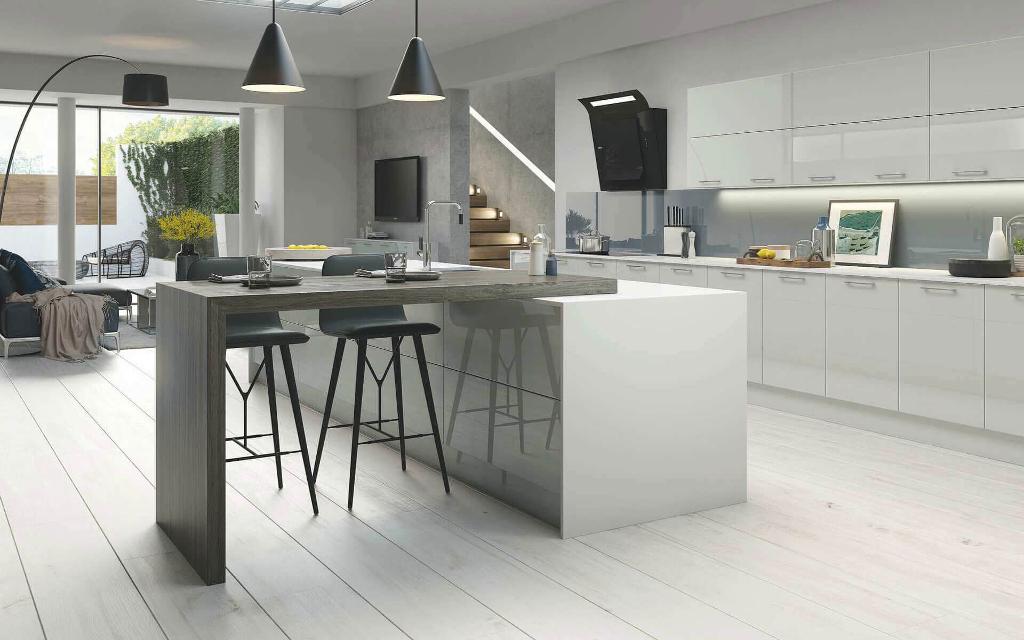
L Shape Kitchen Island in Treviso Light Grey Gloss Modern Kitchen from Better Kitchens
A spacious island offers ample room for meal prep and informal dining, turning into the kitchen's centrepiece. Nevertheless, it's crucial to make sure it doesn't dominate the room or hinder the workflow.
Unconventional designs like round, oval or L-shaped kitchen island can infuse visual appeal and establish various zones within the kitchen, like a cooking area contrasted with a dining or sitting area.
When pondering over the size and shape, it's vital to strike a balance between aesthetics and function – the island ought to augment the practicality of the kitchen whilst enhancing its architectural allure.
- For small kitchen ideas with an island, consider a slimline design that provides storage and prep space but doesn't interrupt the traffic flow. This solution is a practical response to kitchen islands small kitchen needs.
- Kitchen island ideas small kitchen-friendly versions often include innovative storage solutions, like pull-out pantries or sliding cabinets.
- Kitchen island breakfast bar ideas offer a convenient space for quick meals or catching up over coffee. This design also helps to utilise available space effectively in a small kitchen with a breakfast bar.
- In L-shaped kitchens with an island, place the island perpendicular to one of the L legs for optimal workflow and interaction. This is a distinct L shaped kitchen and island design to utilise the maximum space for movement.
- When designing a kitchen island, consider incorporating multi-functional features like a built-in wash-up area or an under-counter appliance garage. These unique kitchen island ideas add value and functionality.
- For a modern touch, consider a kitchen worktop island with a sleek, waterfall- edge countertop in a contemporary material like quartz or polished concrete. These kitchen modern island designs can enhance the aesthetic appeal of your kitchen.
- Designing a small kitchen island with seating can provide a comfortable area for socialising or casual dining, even in a cramped kitchen. This is one of the popular small kitchen island ideas adding both utility and aesthetics.
- Finally, if your kitchen layout doesn't allow for an island, consider kitchen ideas with a peninsula. This design provides similar functionality to an island but requires less floor space.
Exploring Diverse Kitchen Island Styles
Your choice of kitchen island design can considerably impact your kitchen's overall atmosphere and effectiveness.
Be it an inclination towards timeless sophistication, contemporary simplicity, or country appeal, every style carries its distinct character and usefulness.
Classic, Modern, and Rustic Designs
Traditional kitchen island ideas encapsulate beautifully crafted designs with an enduring aesthetic.
Picture using materials like opulent woods, detailed mouldings, and a chic colour spectrum. Modern kitchen islands, on the other hand, gravitate towards sharp, uncluttered lines often emphasising materials such as stainless steel, glass, and high-gloss finishes.
A rustic island design in kitchen, manifests through organic, rugged components like salvaged wood or stone to create a cosy and welcoming ambiance.
Your chosen design should harmonise with your kitchen's overarching theme and should align with your personal style preferences.
Spotlight on Featured Kitchen Islands
Looking into specific kitchen island designs can be a source of inspiration for your own project. Many featured islands present unique design aspects, innovative materials, or superior designs that make them stand out.
This could be an island with highly advanced features, an uncommon shape, or a bespoke piece designed for specific requirements. Such highlights can provide invaluable ideas and fuel imagination for your kitchen design project.
The Kitchen Island as a Central Feature
Regarding your kitchen, understand that an island needn't simply be a practical component; it has the potential to be the focal point both visually and operationally in your kitchen's overall design.
Emphasising Large Islands and Unique Designs
An expansive kitchen island can prove to be a distinct element, acting both as a communal hub and an attention drawer.
Give thought to an island with a distinct concept, such as a contoured or tiered formation, to introduce an appealing aspect and utility.
The crucial part is to harmonise the island's dimension with the overall room's expanse, ensuring it augments rather than swamps the kitchen. Considerate touches like ornamental plating or bespoke fittings can uplift the design.
Colour and Material as Statement Pieces
A well thought-out blend of hues and textures could transform your kitchen island into a captivating focal point.
Opting for vibrant colours or contrasting palettes can effectively command attention while also enabling you to inject a hint of personal style into the room.
Selecting distinctive materials like exotic timbers, marble, or even metals can establish a unique aesthetic.
Play around with varied textures and finishes to infuse more depth and character into your kitchen island, morphing it into a definitive statement piece within your kitchen's design.
Practical Aspects of Kitchen Island Design
The core principle in designing a kitchen island lies in merging beauty with usability, thus crafting a kitchen island that is as practical as it is attractive.
Storage Solutions and Innovative Worktops
Effective storage solutions are an indispensable component when designing a kitchen island.
Think about implementing deep compartments for your pots and pans, slide-out storage for fruits and vegetables, and tailor-made nooks for smaller utensils.
Introducing ground-breaking kitchen worktop island ideas, such as surfaces that resist heat, or those equipped with built-in chopping boards or charging dockets, can augment the usefulness of your island.
The selection of an apt worktop material, whether it's resistant quartz, timeless granite, or inviting wood, can drastically influence both the practicality and visual appeal of your island.
Customising Islands for Smaller Kitchens
In a compact kitchen setting, a meticulously planned island can provide vital additional work and storage areas without overwhelming the space.
Opting for a narrow layout or a moveable island that can be relocated when necessary can be effective. Maximise the utility in a confined space by incorporating space-efficient elements like pull-down tables or retractable components.
Tailoring the island to match the exact measurements and requirements of your kitchen means that even a minimalist kitchen can benefit from a stylish, yet highly operational island.
Frequently Asked Questions about Kitchen Islands
Whether you're planning to build, design, or enhance your kitchen island, our FAQ section offers valuable insights and practical tips to help guide you through the process.
From construction basics to design and decoration ideas, we've got answers to some of the most commonly asked questions about kitchen islands.
How do you build a kitchen island?
The process of constructing a kitchen island is multifaceted, beginning with the creation of a design plan that best corresponds to your kitchen's available space and functionality requirements.
First, take accurate measurements of your kitchen area to determine your island's size. Next, decide on the components you'd like to incorporate in your island, such as storage cabinets, kitchen worktop surfaces, or even appliances.
The aesthetic importance of the materials used cannot be overstated, ensure they harmonise with your existing kitchen décor.
Building an island generally involves the construction of a solid base, usually with cabinetry, followed by the installation of a suitable countertop, concluding with the integration of any preferred appliances and fixtures.
For comprehensive guidance, it may be worth consulting a professional kitchen designer or an experienced carpenter.
How to decorate a kitchen island?
Embellishing your kitchen island can significantly augment both its visual appeal and practical functionality. Consider adding ornamental bowls or plants to introduce a dash of lush greenery.
Utilitarian yet fashionable containers or an elegant fruit bowl can add a functional flair. For an element of individuality, showcase an array of cookbooks or exclusive kitchen implements.
However, ensure to keep the ornamentation minimalist to allow ample space for meal preparation and daily usage.
How wide should a kitchen island be?
The ideal width of your kitchen island largely hinges on your kitchen's overall layout and space. Typically, you can expect it to be around 1 metre (3 feet) in width, albeit this value can fluctuate.
The vital thing is to ensure ample space for unencumbered movement surrounding the island. If your kitchen offers more generous space, a wider island could be more suitable, provided a 1-metre walkway is maintained around the island's entire perimeter.
How to build a kitchen island with seating?
When planning for an island that includes seating, consider factors such as the height of the island and the type of seating you are interested in, such as bar stools or chairs.
You should ensure that there's a minimum of 30 cm or 12 inches of clearance under the countertop for legroom.
For counter-height islands (around 90 cm or 3 feet), opt for counter stools. In contrast, for bar-height islands (roughly 105-110 cm or 41-43 inches ), bar stools would be suitable.
Including overhangs in the countertop design will enhance seating comfort. Consider the number of seats you plan to incorporate and ensure that each guest will have sufficient elbow room.
How to design a kitchen island?
The path to crafting the perfect kitchen island design is dependent on evaluating your kitchen's dimensions, personal requirements, and aesthetic preferences.
Make a decision on the size of the island by looking at the available space in your kitchen, making sure it doesn't interrupt the functionality of the kitchen.
Contemplate its features – including storage capabilities, appliances, and the potential for seating – as well as the types of materials to be used, for instance, the make of the countertop and cabinets.
To ensure the island style aligns with the overarching look of your kitchen, account for your kitchen's existing design theme. Sketch out your kitchen island ideas or make use of design software to better visualise how the island will fit into your space.
How much does a small kitchen island cost?
The price bracket for small kitchen islands can greatly diverge depending on factors like material, dimension and amenities.
The starting point for a simple, diminutive, self-sufficient island units can be a few hundred pounds from Better Kitchens, escalating to several thousands for a bespoke island which utilises deluxe materials and incorporates integrated appliances.
It's prudent to establish a financial plan and investigate options within those confines, taking into account both ready-made and tailor-made choices.
